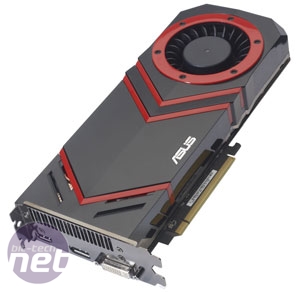Performance Analysis
Our test benches have seen plenty of Radeon HD 5870s over the last eight months, and the Asus HD 5870/G V2 performed as we’d expected for a card with a 2 per cent factory overclock. It was marginally faster than a stock-speed card in some situations, and in many cases exactly the same speed. That still means the Asus HD 5870/G V2 is quick for a single-GPU card though, with Dirt 2 playable right up to 2,560 x 1,600 with 4xAA; we saw a minimum frame rate of 41fps and an average frame rate of 47fps.Performance in STALKER: Call of Pripyat is also excellent, but hardly differed from that of a stock card – the small overclock lead to an increase of only 1fps. Crysis was the same, as the Asus managed an extra 1fps at best compared to a standard HD 5870. The same pattern was repeated in Battlefield: Bad Company 2, with the Asus managing to be 1fps faster than a standard HD 5870 in almost every test resolution.
While the performance of the Asus was only minutely quicker than that of a stock card, the custom cooler can be seen as nothing but a disappointment. Whether it’s due to the high GPU vcore or incorrectly set fan-speed steppings, the Asus was much louder than a normal HD 5870: the 80mm radial fan quickly span up to an audible level once we started playing games.
Surprisingly though, the extra noise and custom cooler deliver no better cooling than a standard HD 5870, with the GPU of the Asus card hitting a delta T of 53°C rather than the 51°C of a stock card. The Asus’ power consumption was also much higher than that of a stock HD 5870, peaking at a total system power draw of 293W under load – 17W more than with a stock model. All this is a bit disappointing, as the Asus not only runs hotter, noisier and thirstier than stock card, but the in-game benefits are marginal at best.
Overclocking
While the Asus Smart Doctor software is on occasion infuriating to use (due to baffling inadequacies such as not being able to smoothly drag the application around and only being able to adjust overclocks using the mouse and not the arrow keys), it does the job of overclocking a graphics card well. The Voltage Tweak function worked perfectly.We'd seen reports of this card hitting the lofty heights of a 1GHz GPU overclock, and considering that we managed such an overclock with Asus' original HD 5870 Voltage Tweak card we expected the same. However, we found our card unwilling to stretch beyond 960MHz, even with heavy overvolting - this was all done with the cooling fan at its default level rather than forced to wind turbine mode, however. Unusually, the card's memory was more open to overclocking, and we were able to increase the frequency to 1,291MHz (5.16GHz effective) - a tidy 8 per cent jump. The combination of the GPU and memory overclocks bought us an extra 1-3fps in Crysis.
Conclusion
While Asus should be commended for producing a card with a shorter custom PCB, cooler and factory-applied overclock for roughly the same price as a standard card, it shouldn’t have bothered. Only if these features improved on the original design would they be worth paying for.In this instance, none of the upgrades Asus has applied to the HD 5870 are attractive (unless you’re after STALKER: Call of Pripyat, which is bundled with the card). The factory overclock is tiny and produced a barely noticeable performance improvement, the card’s peak power consumption was higher than that of a standard model, and the cooler was both hotter and significantly louder than a stock model’s when both cards were under load. With these deficiencies to the Asus Radeon HD 5870/G V2, we’d rather take a plain HD 5870 for around £300.
- Performance
- x
- x
- x
- x
- x
- x
- x
- x
- -
- -
- 8/10
- Features
- x
- x
- x
- x
- x
- x
- -
- -
- -
- -
- 6/10
- Value
- x
- x
- x
- x
- x
- x
- -
- -
- -
- -
- 6/10
- Overall
- x
- x
- x
- x
- x
- x
- -
- -
- -
- -
- 6/10

MSI MPG Velox 100R Chassis Review
October 14 2021 | 15:04












Want to comment? Please log in.